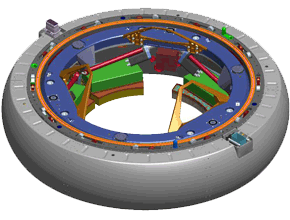Questions & Answers

IDSS Guide
Navigation and Alignment Aids Concept of Operations and Supplemental Design Information
This document supplements the IDSS IDD and provides greater insight into the design and usage of the IDSS navigation and alignment aids. The IDSS committee felt that this information would provide additional insight and considered it important to preserve for future IDSS navigation and alignment aids users.
International Docking Standard System Guide (408 KB PDF)
Common Technical Questions
1. Why have an international docking standard? Why not just release the design of the NASA docking mechanism into the public domain?
An International Standard provides the pathway for any entity, whether government or commercial, to develop a docking system that is compatible with others. Like computer standards such as USB, the goal of this standard is to enable creative, competitive implementations while supporting compatibility.
Releasing the NASA-specific implementation of this docking standard into the public domain is a challenge due to export control restrictions; however the NASA’s design will be compatible with the docking standard.
2. Why have you placed this standard in the public domain?
In order for an international standard to be used it needs to be freely available to interested companies and space agencies.
3. Aren’t you worried that another space agency or commercial company will now produce a propriety version of the docking standard and start charging fees to anyone who wants to use it?
To the contrary, the International Community involved in the development of this standard encourages governments and private companies to develop their own implementations of this standard. This will increase competition and decrease the cost of entry to commercial providers. The existence of propriety implementations does not undermine the compatibility.
4. Why are you seeking technical comments on the standard?
This standard was a collaborative effort by the International Space Station partners. There may be technical implementations that we have overlooked or design details that need further definition in order for this to be a truly international standard that all interested companies and space agencies can use.
5. When is the next revision of the standard due for public release?
April, 2011.
6. No mention of magnet polarity for magnetic latches – how have you specified these to ensure they are androgynous?
The magnetic characteristics will be provided in the next revision. Additionally the current posted standard identifies both the magnet (active component) and striker (passive area of contact) locations.
7. With this standard can anyone now dock to the ISS?
Building to this docking standard ensures compatibility and enables a spacecraft using it to dock to the planned ISS compatible docking ports. A non-ISS partner space agency would need approval of the ISS Multilateral Coordination Board before docking to the ISS and the appropriate international agreements would also need to be put in place prior to the aforementioned docking.
8. I can't find any provision for fuel or power transfer in the documentation. As a "standard" it falls short of what the Russians have been using for forty years now. In an emergency, fuel transfer alone might save a spacecraft without the need to transfer crew to the rescue craft.
Technical details on fuel and power transfer will be addressed in a future revision, most likely after the next release scheduled for April, 2011. Standardization of fuel and power standards is a significant effort in itself. As an example, the Soyuz and Orbiter use different fuels. Oxidizers will also need to be addressed.
9. Why not adopt the Russian standard? Why reinvent the wheel?
The new standard allows for the use of APAS heritage design features while enabling technical advances made available during the past 40 years since APAS was first designed. Specifically the low impact soft capture system is a step forward in delivering reduced energy dockings. Rather than reinventing the wheel, this standard incorporates proven APAS features while advancing the state-of-the-art.
10. I am not an expert on docking systems, but is this compatible with the APAS-95 currently on the 3 PMAs on ISS? What about LIDS? The IDD has appendices about both, but I am not sure about the details. The IDD has many TBDs and TBRs. Because this is so close to APAS-95, can we view this as a significant technology transfer (into the public domain) by the Russian Space Agency?
The IDD TBDs and TBRs will be addressed in the next revision of the standard, scheduled for April 2011. NASA plans to implement this international standard with the NASA Docking System currently under development. The NDS incorporates Low Impact magnetic technology, while accommodating Low Impact Mechanical soft capture technology. The existing IDSS IDD does not result in any technology transfer as defined by ITAR. Physical docking is one thing, but there also needs to be a standard for atmosphere. During Apollo-Soyuz they had an airlock between the two ships: Apollo contained on low pressure pure oxygen, whereas Soyuz contained higher pressure nitrogen-oxygen. Dockings aren't great if one gets the bends after the hatch is swung open.
Clearly, there are many features beyond a docking system that allow spacecraft to be compatible. The IDSS standard is the first step in enabling international compatibility to a common standard. The ISS Multilateral Coordination Board has created three additional standardization working groups to address additional areas: Rendezvous and proximity operations commonality, standardization of protocols for command and support data bus protocols and common sizes and interfaces for replaceable items to include standardizing payload interfaces.